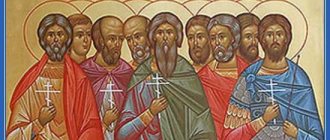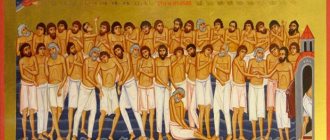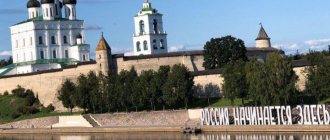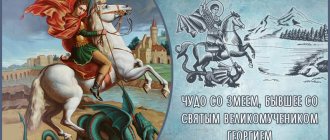It seems incredible that this city, or more precisely, the tomb of St. Mina of Cotuan located here, which was one of the most important Christian shrines and a major center of pilgrimage, was forgotten for more than a thousand years. It was only at the beginning of the 20th century that Abu Mina, located about 45 kilometers from Alexandria in Egypt and destroyed by Persian conquerors in the 7th century, was again discovered by German archaeologists - under almost incredible circumstances. An exhibition at the Bode-Museum in Berlin tells about this and the ancient city of Abu Mina, which arose on the burial site of the remains of the holy great martyr Mina of Cotuan. The exhibition presents fragments of ancient buildings, household items and souvenirs for pilgrims.
Supposed tomb of the holy martyr
There are several contradictory legends about Saint Minus of Cotuan. According to the most common version, the Egyptian soldier Mina of Cotuan, who professed the Christian faith, served in Phrygia at the end of the 3rd - beginning of the 4th centuries. During the persecution of Christians, he did not renounce his faith and accepted martyrdom. Revered primarily by Coptic, Greek and Balkan Christians. On their icons he is often depicted on horseback as a warrior. This is no coincidence: he belongs to the so-called holy warriors along with, for example, St. George the Victorious, Theodore Stratelates, and Dmitry of Thessalonica.
Context
Orthodox and Catholics: love is possible
Aachen relics are revered in both the Catholic and Orthodox worlds.
Therefore, Orthodox believers from many European countries participate in the High Pilgrimage in Aachen. (06/27/2014) Brothers in the faith of Mina of Cotuan transported his body by ship to Egypt. Then the remains of the martyr were carried on a camel. After the next stop, the camel did not want to go further, and the believers accompanying the body saw this as a sign indicating that the body of Mina of Cotuan should be buried here.
Conquest and destruction in the ancient center of pilgrimage
On the site where the legendary tomb of Saint Mina of Cotuan was supposed to be located, religious buildings arose, then a whole city grew up, with a religious center and houses of worship, inns and residential buildings, trading shops and workshops. Numerous believers from all corners of the Roman Empire made pilgrimages to this city.
At the beginning of the seventh century AD, Abu Mina was conquered by the Persians. They stayed in this territory from 619 to 629. During this period the city was destroyed. Later this pilgrimage center came under the care of the Coptic, that is, Egyptian Christian Church. They began to build up the city again and restore the destroyed church, built on the saint’s grave, a century later, but it no longer regained its former beauty and significance. And then it was actually abandoned.
In the summer of 1905, the ruins of the ancient city were found by archaeologist and theologian Carl Maria Kaufmann and his cousin Ewald Falls. This happened by chance, in the last days of an archaeological expedition, which until the discovery of Abu Mina did not bring any results.
Vessel with the image of Saint Mina of Cotuan
The scientists' searches were concentrated in Cyrenaica, a historical region in the territory of modern Libya. Archaeologists made a sensational discovery thanks to a Bedouin boy who brought them a clay jug for storing aromatic oils with an image of Saint Mina of Cotuan between two camels. The trail of this discovery led the archaeological brothers to a kiln for firing clay products, in which they found several more similar ceramic products. Now scientists no longer doubted that they had discovered an ancient Christian shrine.
Centenary excavations
Thanks to the financial support of Frankfurt am Main, the hometown of Karl Maria Kaufmann, as well as Wilhelm von Bode, then director of the Berlin museum that today bears his name, archaeologists were able to begin excavations at Abu Mina in the fall of 1905. The first expedition continued until 1907. Already at this stage, it was possible to discover the remains of a large basilica, Roman baths, and later - a hotel for pilgrims, a baptistery and, of course, many artifacts. In the 1950-1970s, a new Coptic monastery of St. Mina was built here. Now it is also a place of Christian pilgrimage. Due to high groundwater levels, in 2001 the city of Abu Mina was included in the list of UNESCO World Heritage Sites in danger of destruction.
See also:
Treasures of the ancient Etruscans
Gold buckle with the image of a chimera. 7th century BC e. The Etruscans were a very religious and, apparently, very superstitious people. In any case, they believed in chimeras. They deified the forces of nature. Ancient Etruria consisted of 12 city-states, which were united by their religion and a common language, unlike any known language and still not deciphered.
Treasures of the ancient Etruscans
Capitoline wolf. Etruscan bronze sculpture from the 5th century BC. e. The figures of Romulus and Remus were added already in the 15th century. At the same time, this symbol of Rome - the image of a she-wolf, who, according to legend, nursed the twins who founded the city - was transferred to the Capitoline Palace.
Treasures of the ancient Etruscans
Gold clasp of a woman's comb. Second quarter of the 7th century BC. e. Take a closer look: with what skill, how delicately and elegantly this decoration was made by an Etruscan master more than two and a half thousand years ago! Which beauty wore it?..
Treasures of the ancient Etruscans
Female bust from Cerveteri, a city in the province of Lazio, 55 km north of Rome. It was once the richest city in Etruria. Its population at its peak was 25 thousand people. Cerveteri (the Etruscans called it Caere) surrendered to the Romans, and therefore for some time retained relative autonomy in the Roman Empire. Here is one of the largest Etruscan necropolises.
Treasures of the ancient Etruscans
In one of the necropolises of Cerveteri they found this gold-plated dish made in the 7th century BC. e. Today it is kept in one of the Vatican Museums.
Treasures of the ancient Etruscans
Gold earrings in the form of bunches of grapes (IV century BC). Winemaking was one of the most profitable agricultural industries of ancient Etruria. The Etruscans themselves were not averse to drinking heavily, and exported wine to other city-states.
Treasures of the ancient Etruscans
One of the Etruscan burials in today's Tuscany. Rich and noble people were buried in such a mound made of stones. Their tombs could consist of several rooms. They were buried along with things, jewelry and even slaves. Individual mounds were connected to each other to form cities of the dead.
Treasures of the ancient Etruscans
A lid used to cover a sarcophagus with a body or an urn with the ashes of a deceased Etruscan (late 3rd century BC). A magnificent plastic image of a couple reclining on a bed! It was not possible to determine whose ashes were buried in this urn - his or hers.
Treasures of the ancient Etruscans
Sculpture from one of the Etruscan burials. Terracotta, 2nd century BC. e. The Etruscans had a special attitude towards death and the afterlife. They richly decorated the tombs, often depicting the dead, so to speak, in an optimistic spirit - like this Etruscan with a cup in his hand.
Treasures of the ancient Etruscans
Amphora depicting fighting warriors. End of the 6th century BC e. The Etruscans were good warriors and knew a lot about martial arts with or without weapons. It was from them that the ancient Romans later adopted gladiator fights and chariot racing.
Treasures of the ancient Etruscans
The Etruscans did not use such bronze utensils every day. This is a festive service that was used for banquets in the 5th century BC. e. The Etruscans loved to drink well and have fun, as evidenced by numerous frescoes and bas-reliefs depicting feasting and dancing people.
Treasures of the ancient Etruscans
Musicians and dancers. Relief from a tomb of the 6th - early 5th century BC. e.
Treasures of the ancient Etruscans
In the photo: a bronze handle from the lid of a long-rotten wooden box (5th century BC). What was stored in this box, the handle of which depicts two warriors carrying the body of their slain comrade? Some healing ointments? Dressing? Weapon? Like much else in Etruscan history, this remains a mystery.
Great Martyr Mina of Cotuan
Memorial Day: November 11/24
| Great Martyr Mina |
The Holy Great Martyr Mina (strictly speaking, this is the female version of this Greek name, the male version - Minas [59] - Μηνας, as, in truth, the martyr could be called), was an Egyptian by birth, was a warrior and served in the city of Cotuan under the command of the centurion Firmilian in the reign of the emperors Diocletian and Maximian (284 - 305). When the co-rulers began the most severe persecution of Christians in history, the saint did not want to serve the persecutors and, leaving his service, retired to the mountains, where he labored in fasting and prayer. One day, during a pagan holiday, the saint came to the city in which he had previously served. In the midst of the festive games, which the whole city had come to watch, the accusatory voice of the saint of God was heard, preaching faith in Christ, the Savior of the world. Blessed Mina, having foreseen the Holy Spirit about this holiday, was kindled by zeal for God and, leaving the mountains and deserts, came to the city. Having entered the middle of the place where the spectacles were taking place, the martyr stood on a raised platform so that he could be seen by everyone, and exclaimed in a loud voice: “Those who did not seek Me found me; I have made myself known to those who did not ask about me” (Rom. 10:20).
When Saint Mina exclaimed thus, all those present at the spectacle fixed their gazes on him and fell silent, amazed at his courage. The ruler of the city, Pyrrhus, ordered the “impudent man” to be taken and began interrogation.
Before the court of the ruler Pyrrhus, the saint courageously confessed his faith and said that he had come here to expose everyone in wickedness. Saint Mina rejected the offer to sacrifice to the pagan gods, accepted the most severe torment, after which he was beheaded in 304. The body of the holy martyr was ordered to be burned. At night, Christians collected the surviving remains of the martyr from the extinguished fire, which they placed in the temple named after him, built after the end of the persecution on the site of the suffering and death of the Great Martyr Mina.
Troparion of Mina
As an incorporeal interlocutor / and a passion-bearer of the same occupant, / having come together in faith, Mino, we praise you, / ask for world peace / and great mercy for our souls.
| Victor Damassky | Stefanida the Martyr |
Martyrs Victor and Stefanida
Memorial Day: November 11/24
The holy martyr Victor was a warrior originally from Italy during the reign of Emperor Marcus Aurelius the Philosopher (161 - 180) and served in Syria under the command of the commander Sebastian. When the emperor began persecuting Christians, Victor refused to make a sacrifice to the gods when the commander of the legion conveyed the emperor's command to the soldiers. Such a mandatory sacrifice was a test of the warrior’s devotion to the gods, the emperor and the fatherland. The saint was given over to be tortured, but passed through all the tortures unharmed. They pulled out his veins, threw him into a furnace, boiling oil, broke off his fingers, but every time the power of God strengthened him and he remained purposeful and did not waver in his faith. By the power of prayer, he defeated the sorcerer, who intended to poison the saint, but, having eaten the poisoned meat, the saint, through the action of Divine grace, remained alive and well, and the sorcerer has since renounced sorcery and become a Christian. Through the prayer of the saint, the suddenly blind soldiers regained their sight. This happened after they hung the saint upside down (after gouging out his eyes) and kept him like that for three days, and on the fourth they decided to take him down, thinking that he was dead, but he turned out to be alive and during a fit of fright they went blind and Through the prayers of the saint they were healed. Seeing the miracles revealed by the Lord through Saint Victor, the young pious wife of one of the tormentors, Stefanida, openly glorified Christ, for which she was given a cruel execution: she was tied to two bent palm trees, which, straightened, tore the martyr apart. The holy martyr Victor was beheaded. The martyrs suffered in Damascus in the 2nd century, where their honorable remains were buried.




